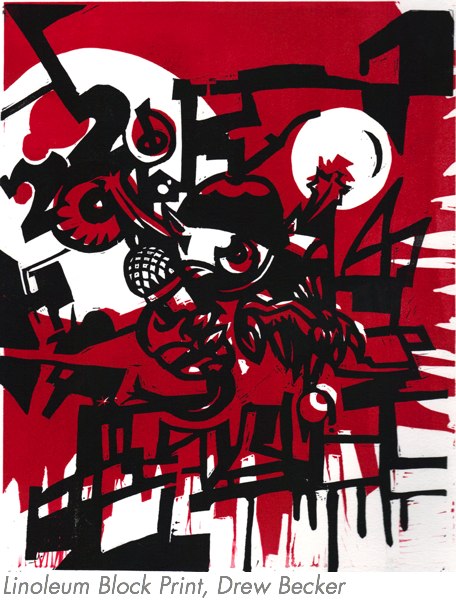Get Ink On Your Hands
05.07.09 · Marc Bosworth
My interest in printmaking goes back a long way. At age 18, I was fortunate to land a job as an artist at a screen-printing shop that produced mostly T-shirts. In those days, the color separations were created by carefully hand-cutting and peeling layers of delicate plastic called rubylith. In addition to creating all the art, my duties included stretching, coating and burning screens, making film positives in the darkroom using a large copy camera, and occasionally pulling a squeegee or stacking and folding freshly printed shirts as they came off the end of the dryer. In college, I studied fine art with an emphasis on drawing, eventually earning a master’s degree in printmaking from Wichita State University.
These days, I teach a night class in printmaking at Friends University in Wichita. My students, many of them graphic design majors, are typically about the same age that I was when I started my first screen-printing job. In one action-packed semester, they learn how to make monoprints, linoleum-block prints, collagraphs, screen-prints, drypoints and etchings. We also tour the facility at WSU so the students can see the big lithographic limestones, and see what a well-equipped printmaking studio looks (and smells) like.
Old School is New School
The class I teach is very hands-on. Students have to do things such as bevel copper plates with files. They run the risk of slicing fingers with sharp linoleum carving tools. They get their hands dirty. What’s more, though the inks and materials have improved much over the years, the techniques are ancient. They have no place in a world of all-in-one printer-scanner-copiers. They are obsolete. Or are they?
There is no better way for a young graphic designer to experience things such as registration, trapping, overprinting. No better way to understand the importance of putting the right kind of ink on the appropriate substrate. And for someone who may someday be doing press checks, there is no better way to learn to appreciate the craft and skill that it takes to be a good pressman.
And even if digital printing technologies someday completely replace those pressmen, there is more to it. I don’t often hear students whine and I’ve never been asked, “What’s the point?” Instead, they seem to relish a chance to practice hand skills on something other than texting. They quickly become attuned to the details, the subtleties of marks and textures that are unique to printmaking. Though they are in some ways very sophisticated and savvy, these children of the digital age find reassurance in the fact that their world is still grounded in things much more tactile than the click of a mouse. One student summed it up best by saying, “This is great! It’s like Photoshop, except that it’s real!”
The Ink Sticks
At the end of this semester, I was working late at home, grading final projects. When I finished grading, I took a stack of prints back over to school to leave for the students to pick up. At 11:30 on a Tuesday night I was surprised to find two of my students hard at work in the studio making some new prints – this after all their work for the class had already been turned in and graded.
The other day, I ran into a former student who is doing well as a designer with a local studio. He told me excitedly how he had just bought a platen press – the kind traditionally used for letterpress printing – for his own enjoyment. It seems that printmaking is making a lasting impression on some of these young minds.
